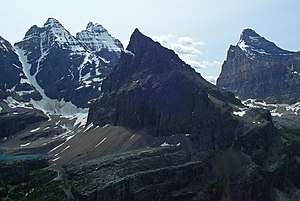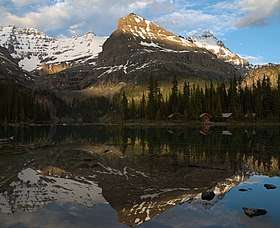Yukness Mountain
Yukness Mountain is a 2,851-metre (9,354-foot) summit located southeast of Lake O'Hara in the Bow Range of Yoho National Park, in the Canadian Rockies of British Columbia, Canada. Its nearest higher peak is Ringrose Peak, 1.0 km (0.62 mi) to the east.[1]
| Yukness Mountain | |
|---|---|
 Yukness Mountain (center) with Ringrose and Hungabee to left and Biddle to right | |
| Highest point | |
| Elevation | 2,851 m (9,354 ft) [1][2] |
| Prominence | 161 m (528 ft) [1] |
| Parent peak | Ringrose Peak (3292 m)[1] |
| Listing | Mountains of British Columbia |
| Coordinates | 51°20′41″N 116°18′18″W [3] |
| Geography | |
 Yukness Mountain Location of Yukness Mountain in British Columbia  Yukness Mountain Yukness Mountain (Canada) | |
| Location | British Columbia, Canada |
| Parent range | Canadian Rockies |
| Topo map | NTS 82N08[3] |
| Geology | |
| Age of rock | Cambrian |
| Type of rock | sedimentary rock |
| Climbing | |
| First ascent | 1918 Survey Party[1] |
| Easiest route | Scramble[1] |
History
In 1894 Samuel E.S. Allen named it "yukness" for the Stoney language expression for "sharpened with a knife" because it does appear as a knife-edge peak when viewed from Lake O'Hara.[4][5]
.jpg)
Walter Wilcox wrote about Lake O'Hara and Yukness Mountain: "Soon we came upon the western end of as beautiful a lake as I have ever seen. While showing neither glaciers nor snow upon the immediate peaks, the immense walls to the left and the cliffs and ideally pyramidal peak to the right formed a foreground of wonderful grandeur. The northwest end on which we stood fringed the emerald water with a growth of pine. The south east end facing us was encircled with cliffs five hundred feet in height, from whose summit, piled high with the rocks of an old moraine, three slender waterfalls leaped into the lake. This lake, about a mile in length and slightly less in width, I have known as Lake O'Hara. Ascending the cliffs upon our left by a gully we reached the glacial dam. The bed of an ancient glacier behind this is occupied by a very small lake, at the base of the sharp peak of which I spoke, and which I called by the Indian equivalent, Yukness."[6]
The first ascent of the mountain was made in 1918 by a survey party.[1]
The mountain's name was made official in 1952 by the Geographical Names Board of Canada after it had been incorrectly changed to Mount Yukness.[3]
Geology

Yukness Mountain is composed of sedimentary rock laid down during the Precambrian to Jurassic periods.[7] Formed in shallow seas, this sedimentary rock was pushed east and over the top of younger rock during the Laramide orogeny.[8]
Climate
Based on the Köppen climate classification, Yukness Mountain is located in a subarctic climate with cold, snowy winters, and mild summers.[9] Temperatures can drop below −20 °C with wind chill factors below −30 °C. Precipitation runoff from Yukness Mountain drains into Lake O'Hara, thence into the Kicking Horse River which is a tributary of the Columbia River.
References
- "Yukness Mountain". Bivouac.com. Retrieved 2019-01-03.
- "Yukness Mountain, Canada". Peakbagger.com. Retrieved 2019-11-10.
- "Yukness Mountain". Geographical Names Data Base. Natural Resources Canada. Retrieved 2019-01-03.
- "Mount Yukness". PeakFinder.com. Retrieved 2019-11-10.
- "Yukness Mountain". BC Geographical Names. Retrieved 2019-11-10.
- Eternal Lake O'Hara, Carol Ann Sokoloff author, 1993, Ekstasis Editions Canada
- Belyea, Helen R. (1960). The Story of the Mountains in Banff National Park (PDF). parkscanadahistory.com (Report). Ottawa: Geological Survey of Canada. Archived (PDF) from the original on 2015-10-02. Retrieved 2019-09-13.
- Gadd, Ben (2008). Geology of the Rocky Mountains and Columbias.
- Peel, M. C.; Finlayson, B. L. & McMahon, T. A. (2007). "Updated world map of the Köppen−Geiger climate classification". Hydrol. Earth Syst. Sci. 11: 1633–1644. ISSN 1027-5606.